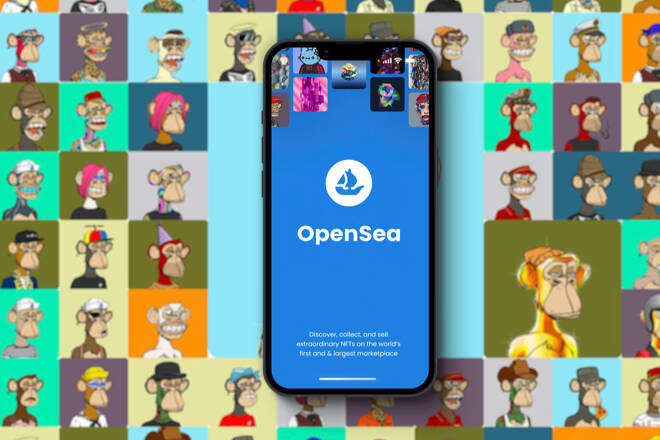Advertisement
Advertisement
Everything You Need to Know About OpenSea
By:
Launched in 2017, OpenSea is the leading NFT marketplace. While trading volumes have collapsed, the platform is well placed for a comeback.
OpenSea is the first Non-Fungible Token (NFT) marketplace. Despite increased competition in the NFT space, OpenSea remains the market leader.
Devin Finzer and Alex Atallah founded the platform in 2017.
Since the beta launch in December 2017, OpenSea has more than 200,000 employees and 600,000 users. OpenSea has delivered more than 80 million NFTs to market. Comprising more than two million NFT collections, trading volumes are more than $20 billion.
In the early days, the platform supported the trading of CryptoKitties. Launched on the Ethereum (ETH) blockchain in November 2017, CryptoKitties is a blockchain game developed by now renowned Dapper Labs, who is also behind the NBA’s TopShot, among others.
In the early days of digital assets, players could create, own, and trade virtual kitties, each kitty a one-of-a-kind.
The OpenSea vision later extended beyond CryptoKitties, with OpenSea also offering a platform and the necessary tools to enable users to trade, create, and even launch their own digital works and collections.
Initially offering Ethereum-based NFTs, the platform has evolved to offer Polygon (MATIC) and Solana (SOL)-based NFTs to its ever-growing user base.
From CryptoKitties to Billionaires to Expansion Mode
Such has been the furor over NFTs that co-founders Finzer and Atallah became the first NFT billionaires in 2021, all thanks to CryptoKitties.
In January 2022, FX Empire reported news of OpenSea raising $300 million in Series C Funding and an OpenSea valuation of $13.3 billion.
OpenSea stated four goals for the funding, including:
- Accelerate product development.
- Improve customer support and safety.
- Invest in the wider NFT and Web3 community.
- Grow the OpenSea team.
At the time, the platform’s ultimate goal was to lower the barrier to entry and provide an environment for users to “discover, manage, and showcase their NFTs with better tools, analytics, and presentation.”
NFT Market Explodes with OpenSea Enjoying Record Trading Volumes
OpenSea has been at the forefront of NFT activity since its genesis year. Major NFTs and collections passing through the OpenSea marketplace include CryptoPunks, Bored Ape Yacht Club, Mutant Ape Yacht Club, and Otherdeed for Otherside.
2021 was a bonanza year for the NFT space and OpenSea. The competition was light, with investor interest in NFTs rampant.
In January 2022, ETH-based NFT trading volumes hit a record high of $4.86bn.
According to Dune Analytics, the previous record stood at $3.42bn in August 2021.
The record levels coincided with record highs for Polygon-based NFT trading and OpenSea’s expansion to support Solana-based NFTs.
Polygon-based NFT trading volumes never reached ETH levels. In January 2022, trading volumes hit a record high of $79.1 million.
Market conditions within the digital asset space began to deteriorate in February.
OpenSea trading volumes retreated for two consecutive months before an April rebound.
Contributory factors to deteriorating trading volumes included a sharp rise in illicit activity, the beginnings of the crypto winter, increased regulatory scrutiny, and competition.
After hitting $3.49 billion in April, ETH-based trading volumes fell back to $2.60 billion in May. For June, trading volumes are a lowly $494.6 million. Barring a marked recovery in NFT activity, ETH-based trading volumes will be the eighth lowest since launch and the lowest since $329.0 million in July 2021.
For OpenSea, the inclusion of Solana-based NFTs to drive trading volumes in 2022 also disappointed. While Ethereum and Polygon-based trading volumes have shrunk, recent Solana-based trading volumes give hope.
Solana-based trading volumes hit record highs in recent days.
Competition, Illicit Activity, and a Crypto Winter Hit Volumes
The surge in trading volumes at the turn of the year and the ballooning interest in NFTs led to increased competition.
In 2022, several NFT marketplaces launched, eating into the OpenSea market share.
LooksRare (LOOKS) launched in January 2022, with trading volumes reportedly surpassing OpenSea. However, reports of wash trading surfaced to leave LooksRare on the back foot. Coinbase also announced plans to launch Coinbase NFT.
A likely strong competitor, Coinbase reported more than 2.5 million people joining the Coinbase NFT waitlist.
With increased activity and consumer interest, illicit activity across the NFT space dampened the mood.
On top of wash trading, NFT thefts and rugpulls grabbed the news headlines. While lawmakers looked to punish criminal activity, the NFT space also landed on the radar of governments and regulators.
The US and the UK governments joined a growing list raising concerns over NFTs. The main areas of concern were money laundering and the funding of illegal activity.
To add to OpenSea’s woes has been the lengthy crypto winter, exasperated by Fed monetary policy and the rising threat of a global recession.
Year-to-date, Ethereum is down 73%, with Polygon and Solana down by 86% and 81%, respectively.
A shift in sentiment towards the economic outlook will likely be needed to support a change in OpenSea’s fortunes.
As we have seen with the crypto market, a rebound is likely, and OpenSea remains well-placed to drive the evolution of the NFT space.
This year, there has been a surge in Web3 interest, with mainstream players entering the digital asset space. The increased interest also paints a positive outlook once the dust settles from the 2022 crypto meltdown.
About the Author
Bob Masonauthor
With over 28 years of experience in the financial industry, Bob has worked with various global rating agencies and multinational banks. Currently he is covering currencies, commodities, alternative asset classes and global equities, focusing mostly on European and Asian markets.
Did you find this article useful?
Latest news and analysis
Advertisement
